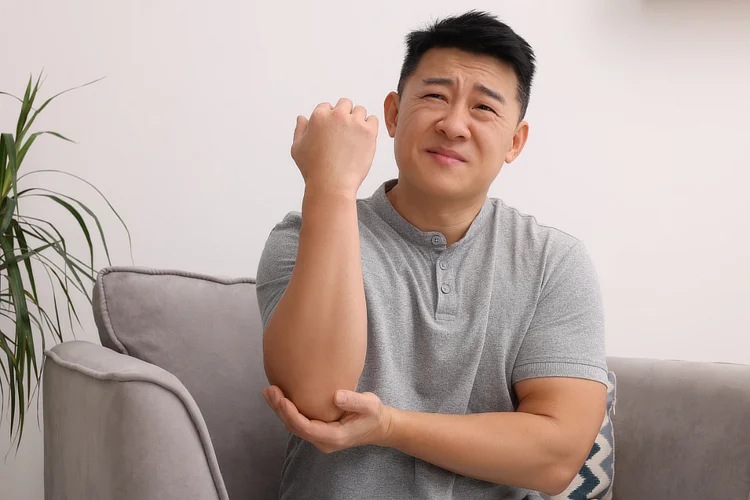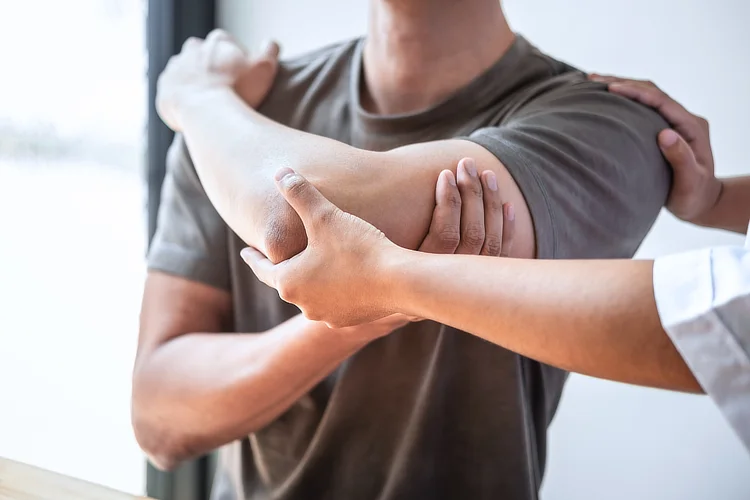Elbow Pain Singapore: Causes, Symptoms, and Treatment Options
Information reviewed by: Dr. Foo Gen Lin | Last updated: Oct 29, 2025
Elbow pain can result from tendon injuries, nerve compression, or joint strain due to repetitive use. Dr Foo offers detailed assessment and targeted treatment to relieve pain, restore function, and prevent further injury.
MBBS (University of London) | MMed (Ortho) | FRCSEd (Ortho) | FAMS (Ortho)



What Is Elbow Pain?
Elbow pain refers to discomfort or soreness around the elbow joint, often
caused by injuries, repetitive movements, or underlying medical conditions.
The pain can range from mild to severe and may affect daily activities such as lifting, gripping, or
bending the arm. If left untreated, it could lead to chronic pain, reduced mobility,
and long-term joint damage.
Elbow Pain Causes
Elbow pain can occur due to injuries, overuse, or medical conditions affecting the muscles, tendons, ligaments, or bones in the elbow joint. Common causes include:
- Tennis Elbow (Lateral Epicondylitis) – Repetitive wrist and arm movements, such as those in racquet sports or manual labour, can lead to small tears in the tendons on the outside of the elbow.
- Repetitive Strain Injuries (RSI) – Continuous repetitive motion can cause microtears in tendons, often seen in office workers, athletes, and manual labourers.
- Golfer’s Elbow (Medial Epicondylitis) – Similar to tennis elbow but affecting the tendons on the inner side of the elbow, often caused by repetitive gripping or wrist flexion.
- Olecranon Bursitis – Inflammation of the bursa, a fluid-filled sac that reduces friction in the elbow joint, often resulting from prolonged pressure or overuse.
- Elbow Arthritis – Osteoarthritis or rheumatoid arthritis can cause joint degeneration, inflammation, and pain.
- Nerve Compression (Cubital Tunnel Syndrome) – Compression of the ulnar nerve, typically at the elbow, may cause numbness, tingling, or pain.
- Fractures or Dislocations – Trauma, such as falls or direct impact, may cause fractures or joint dislocations.
Elbow Pain Symptoms
Symptoms of elbow pain can vary depending on the underlying cause. Common signs include:

- Pain or Discomfort – Pain can range from mild to severe, worsening with movements like gripping, lifting, or rotating the arm. It may feel like a dull ache, sharp pain, or burning sensation.
- Swelling or Tenderness – Inflammation may cause the elbow to swell, turn red, or feel warm to the touch. Tenderness often indicates tendon or joint involvement.
- Stiffness or Limited Mobility – Difficulty bending, extending, or rotating the elbow, especially after periods of inactivity, can suggest joint, tendon, or ligament issues.
- Numbness or Tingling – Sensory changes, particularly in the ring and little fingers, may signal nerve compression, such as cubital tunnel syndrome.
- Weakness – Muscle weakness can reduce grip strength and affect arm function, making tasks like holding objects or turning a doorknob more challenging.
How Is Elbow Pain Diagnosed?
Diagnosing the underlying causes of elbow pain typically involves a detailed medical history review, physical examination, and, if needed, diagnostic tests. The diagnostic process may include:

- Medical History Review – Understanding your presenting symptoms, activity levels, previous injuries, and any underlying medical conditions that may contribute to elbow pain.
- Physical Examination – Assessing tenderness, swelling, range of motion, and muscle strength to identify affected areas and evaluate joint function.
- Imaging Tests – X-rays can identify fractures, arthritis, or joint misalignment. MRI scans provide detailed images of soft tissues, such as tendons, ligaments, and muscles, while ultrasound scans offer real-time imaging to detect tendon tears or inflammation.
- Nerve Conduction Studies – Electromyography (EMG), a diagnostic test that measures electrical activity in muscles, may be used to assess nerve function, particularly when nerve entrapment, such as cubital tunnel syndrome, is suspected.
Elbow Joint Pain Treatment
Treatment for elbow pain typically involves a combination of approaches, depending on the underlying
cause, severity of symptoms, and impact on daily activities. Non-surgical treatments are generally
recommended for mild to moderate cases, while surgical intervention may be considered for severe
pain or conditions that significantly affect elbow function.
Common treatment options include:
| Treatment | Purpose |
|---|---|
| Non-Surgical Management | |
| Rest and Activity Modification | Reduces repetitive stress on muscles, tendons, and ligaments by modifying activities that trigger pain, allowing tissues to recover. |
| Orthotic Devices | Braces, splints, or elbow supports limit movement and offload pressure from affected tendons, reducing strain and promoting healing. |
| Swelling & Pain Management | Application of cold or heat packs to relieve inflammation, reduce pain, and improve circulation. Non-steroidal anti-inflammatory drugs (NSAIDs) can also help manage pain and inflammation. |
| Physiotherapy | A structured exercise programme targeting forearm muscles and tendons to reduce strain on the elbow joint, restore range of motion, and improve grip strength. |
| Injection-Based Treatment | Corticosteroid injections may be used for persistent inflammation around the irritated tendons or bursae. Platelet-Rich Plasma (PRP) therapy can enhance tissue regeneration by delivering growth factors directly to the affected area. |
| Surgical Intervention | |
| Arthroscopy | A minimally invasive procedure using a small camera to remove loose bodies, inflamed tissue, or bone spurs, improving joint mobility. |
| Tendon Repair Surgery | Surgical repair or reattachment of damaged tendons, such as the ulnar collateral ligament (UCL) in Tommy John Surgery, to restore function and alleviate persistent pain. These procedures are commonly performed for conditions like tennis or golfer’s elbow. |
| Nerve Decompression Surgery | Surgical release of compressed nerves to relieve pressure, particularly in conditions like cubital tunnel syndrome, to alleviate pain, numbness, and muscle weakness in the forearm and hand. |
When Should You See a Specialist for Elbow Pain?
You should consult an elbow specialist if you experience:
- Persistent pain lasting more than a few days or worsening over time.
- Swelling, redness, or warmth, which may indicate an infection.
- Restricted or painful elbow movement that affects daily activities.
- Numbness, tingling, or muscle weakness, which could suggest nerve involvement.
- Pain following an injury, especially if there is a visible deformity.
How Can You Prevent Elbow Pain?
Preventing elbow pain often involves adopting habits that reduce strain on the joint. Practical measures include:

- Maintaining Proper Technique – Use correct techniques during sports or work tasks to minimise stress on the elbow and prevent overuse injuries.
- Regular Stretching and Strengthening – Stretching prior to activity helps to improve flexibility and maintain a full range of motion, while strengthening exercises build muscle support for joint stability and injury prevention.
- Make Ergonomic Adjustments – Set up your workspace to maintain proper arm positioning, especially if you spend long hours at a computer. You may also wish to use an ergonomic mouse or keyboard.
- Listening to Your Body – Take breaks when discomfort arises and ease back into activities gradually to prevent recurrent pain.
Every patient deserves a treatment plan tailored to their needs. We start with non-surgical approaches before considering more invasive interventions.
Where Can I Find an Elbow Specialist in Singapore?
Apex Novena
admin@apexsportsclinic.sg
101 Irrawaddy Rd, #18-12 Royal Square Medical Centre, Singapore 329565
Nearest MRT: NS20 Novena
Apex East Coast
admin@apexsportsclinic.sg
112 E Coast Rd, #03-03/04 i12 Katong, Singapore 428802
Nearest MRT: TE26 Marine Parade
Why Do Patients Choose Apex Sports Clinic?
Sports Doctor in Singapore: Personalised & Affordable Care
Progressive Treatment Philosophy
We prioritise personalised, non-invasive solutions, progressing to specialised treatments, including surgery, only when needed for more effective and targeted care.
Holistic Patient-Centred Care
From diagnosis to rehabilitation, we provide comprehensive and seamless care for a wide range of orthopaedic conditions.
Specialist in Sports Orthopaedics & Injury Management
We combine expert injury management with a proactive approach to maintaining your body's strength and function, so you can recover fully and perform at your peak.
Patient Journey
1 . Schedule Your Appointment

2 . Expert Diagnosis & Consultation

3 . Customised Treatment Plan

Schedule an Appointment

Our Insurance Partners






Frequently Asked Questions (FAQs)
The fastest way to relieve elbow pain is to rest the joint, apply cold packs to reduce inflammation, and take over-the-counter anti-inflammatory medication if appropriate. These short-term measures may help ease discomfort, but ongoing or worsening symptoms could indicate an underlying issue. If your pain persists or worsens, it is advisable to consult a doctor or specialist for a proper diagnosis and treatment plan tailored to the specific cause of elbow pain.
The most common cause of elbow pain is overuse-related tendon injuries such as tennis elbow or golfer’s elbow, which result from repetitive movements that strain the forearm muscles and tendons. Other frequent causes include bursitis, arthritis, or nerve compression. Identifying the source of pain early can help guide appropriate management and prevent further injury.
You should see a doctor or specialist if elbow pain persists beyond a few days, worsens over time, restricts movement, or is accompanied by swelling, numbness, or weakness. Pain following trauma or injury with visible deformity also warrants prompt medical attention.
You should avoid stretching the elbow during episodes of acute pain or inflammation, as it may worsen the condition. Gentle stretching may be helpful during the recovery phase to restore flexibility. If your pain persists or gets worse, it is advisable to consult a doctor or specialist for proper diagnosis and management.
Squeezing a ball may help strengthen forearm muscles during the later stages of tennis elbow recovery but may aggravate symptoms if done too early. Proper timing and technique are essential to avoid further strain. It is advisable to consult a doctor or specialist before starting such exercises to ensure suitability.
Elbow pain can go away, particularly if it is caused by mild strain or overuse and addressed early with rest and appropriate treatment. However, ongoing or recurring pain may signal an underlying condition that requires further assessment. If symptoms persist or worsen, it is advisable to consult a doctor or specialist to determine whether additional care is needed to support recovery.
Elbow pain is not typically caused by a single deficiency, but low levels of vitamin D or calcium may contribute to general joint or bone discomfort. Nutritional deficiencies may also exacerbate pain related to existing conditions such as arthritis. It is advisable to consult a doctor or specialist to evaluate whether dietary factors are contributing to elbow pain and to guide appropriate testing and treatment.
Elbow pain from arthritis often presents as stiffness, swelling, and reduced range of motion, particularly in the morning or after rest. The discomfort may worsen with activity and be accompanied by a grating sensation or visible joint changes. Consulting a doctor or specialist can help determine whether arthritis is the cause through clinical assessment and imaging.
If left untreated, elbow pain can become chronic and may lead to complications such as tendon degeneration, joint stiffness, or nerve compression. It may also limit daily function and increase the likelihood of requiring more intensive treatment later. If your symptoms persist or worsen, it is advisable to consult a doctor or specialist for proper evaluation and care.
Elbow joint pain may be a symptom of various conditions, including tendonitis, arthritis, bursitis, nerve compression, or joint injury. The underlying cause often depends on the location of the pain, recent activities, and accompanying symptoms. If your discomfort persists or worsens, it is advisable to consult a doctor or specialist for proper diagnosis and appropriate management.
Elbow pain can sometimes be a sign of a more serious condition, such as a fracture, joint infection, or nerve compression, particularly if it worsens quickly or affects mobility. Red flags include numbness, visible deformity, or symptoms like fever. If your pain persists or worsens, it is advisable to consult a doctor or specialist for proper diagnosis and timely management.

